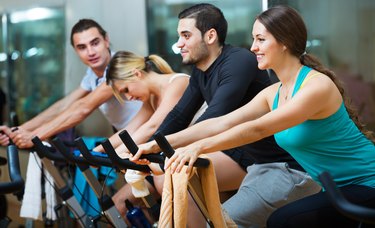
A good exercise program helps patients with spinal stenosis slow the progress of the disorder. For many, spinal stenosis is acquired from or worsened by other medical conditions such as osteoporosis. Those with spinal stenosis have a spinal column that is narrower than normal, causing possible nerve impingement, bone spurs or grating. Certain exercises may increase pain or the chance of injury. Speak with your medical provider prior to starting a new weight-training program.
Doctor's Evaluation
Video of the Day
Your doctor will use diagnostic images to see a picture of your spine to identify the areas where narrowing is most severe, possibly causing pain and numbness in arms or legs. Magnestic resonance imaging and X-rays are two diagnostic aids coupled with nerve conduction testing and patient history are used in treatment. Patients experiencing severe pain or loss of extremity function may require surgery to remove bone spurs, eliminate herniated disc sections or perform a complete spinal fusion to create more space in the spine. Dealing with any underlying causes such as osteoporosis or osteoarthritis is imperative since these conditions hasten the progress of stenosis symptoms and pain.
Video of the Day
Recommended Exercise Programs
Doctors recommend non-jarring, low-impact sports and activities for stenosis patients. Less impact reduces compression in the spine that can increase pain or nerve damage. Swimming, elliptical machines, cycling and walking are aerobic activities recommended by Peter F. Ullrich, Jr., M.D. at the Spine-Health website. Cardiovascular conditioning helps deliver nutrients to the spine to help repair and nourish it. It also helps patients keep weight down to lower the strain on the spine.
Benefits
Weight-bearing exercises help bones maintain density and retain strength. This is especially important for those with osteoporosis where bone density drops with age and bones become brittle. Osteoporosis increases stenosis symptoms as the space between vertebrae gets smaller. Weight-lifting slows the progress according to the University of Arizona, "Bone Builders" series. Even those who don't have stenosis from osteoporosis will benefit from a moderate weight training program that works the core back, neck and abdominal muscles. Stronger core muscles support the spine more effectively, helping reduce back pain according to Thomas E. Hyde, D.C. at the Spine-Health website.
Risks
Consider the risks prior to using weights and talk to your doctor or physical therapist about limits. Using too much weight on an exercise such as the bicep curl causes many lifters to throw their back into the movement to thrust the weight up. Not only does this make the exercise less effective to the biceps, it stresses the back. Patients who have spinal stenosis increase the chance of injury performing certain types of weight-lifting moves. Exercises such as the snatch, dead-lift, squat and clean-and-jerk are extremely stressful on the spine as well as surrounding muscles. Less weight with more repetition is recommended for stenosis patients.
Weight-Lifting Versus Strength Training
Patients can build muscle doing different types of training programs. Weight training is a load-bearing resistance exercise. Certain types of tai chi, yoga and Pilates are also recommended to build core muscles through postures, according to Hyde. Resistance band training is another way to create strength. These options should be discussed with your doctor as a means to develop the proper strength in your core muscles and your extremities without heavy weights.
Is this an emergency? If you are experiencing serious medical symptoms, please see the National Library of Medicine’s list of signs you need emergency medical attention or call 911.